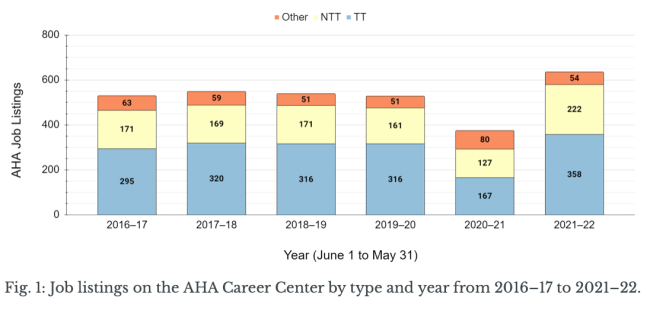You have /5 articles left.
Sign up for a free account or log in.

After a pandemic-era dip, the number of history job ads increased in 2021–22.
American Historical Association
In 2020–21, history faculty job postings hit their lowest point since the American Historical Association started tracking openings in 1975, at just 347 positions total.
“Pandemic-related austerity measures, hiring freezes, and the like were implemented by almost every U.S. university, and the resulting downturn was as expected as it was unwelcome,” says a report on the COVID-era job market, out this week in the AHA’s Perspectives on History magazine.
According to the report, written by editor Leland Renato Grigoli, the availability of jobs from 2016–17 to 2019–20 had been stable, as had the relative ratios of tenure-track, non-tenure-track and nonteaching jobs. Specifically, the period saw an average of 536 jobs listed per year: 312 tenure-track jobs, 168 non-tenure-track jobs and 56 nonteaching positions. This represented something of a rebound from the Great Recession.
Enter COVID-19. From June 2020 to the end of May 2021, just 347 positions were listed with the AHA Career Center, a significant decline from the year before. Posted tenure and tenure-track positions declined by about half, to 167, a “historic low.” Non-tenure-track positions dropped from 161 to 127, according to the AHA’s report.
The number of nonfaculty jobs listed (mostly nonteaching jobs within college and universities) increased from 51 to 80 positions, however.
The Current Outlook
Are things improving? Yes and no.
According to the AHA’s report, some 634 positions were listed from June 2021 to the end of May 2022—a major increase from the previous year’s 347 jobs and an increase from even the 2019–20 (pre-pandemic) listings. Of these 634 jobs, 358 were on the tenure track, an increase from both 2020–21 and 2019–20. There were 222 non-tenure-track listings, more than in each of the earlier two years. Noninstructional jobs ads, meanwhile, dropped to 54.
H-Net, another popular job listing site, showed a similar year-over-year increase, with 670 jobs in history and area studies for 2021–22.
While job ads jumped in 2021–22 relative to 2020–21, the average number of AHA job ads for the two years is 505, lower than the post-recession annual average of 536. Moreover, the AHA’s report says, there is a drop in the number of tenure-track listings when the 2020–22 average is compared to the average listings for the four years prior to the pandemic: 263 to 312.
The ratio of non-tenure-track to tenure-track job offerings, which had remained steady from 2016 to 2020, "has shifted decisively toward contingent labor during the pandemic," the report says. "Universities are delaying or forgoing tenured hires in favor of short-term appointments.”
As for what kind of expertise institutions are looking for, ads for world history jobs and listings categorized as “other/open” saw similar overall increases, the AHA found. The open category jobs were mostly tenure track, but the majority of world history jobs were contract.
Scholars seeking jobs in Asian and Latin American history saw “substantial” increases in both permanent and contingent positions, while African historians saw fewer non-tenure-track listings in 2021–22 than the year prior. “The relatively small number of listings for these fields, however, makes it difficult to judge whether these variations are significant,” the report says.
Nonfaculty Jobs and Sobering Data on History Majors
Beyond academic job listings, Grigoli wrote that 15 percent of new history Ph.D.s immediately took nonacademic jobs, citing the 2021 federal Survey of Earned Doctorates. These jobs were in government, business, nonprofits and K-12 and other positions.
Some 1,799 historians earned their Ph.D.s in 2019 and 2020, based on federal data. According to information from the AHA’s directory of history departments, 175 are now employed as full-time faculty members.
“Taken together, these indicators should encourage a continuing focus on maintaining strong and diverse career options for history Ph.D.s at all U.S. institutions,” the AHA’s report says. “Even with the significant rebound in academic hiring in the past year—at least relatively speaking—finding a permanent faculty position is and will remain extremely difficult for the foreseeable future.”
According to a recent analysis of federal data on COVID-19–era undergraduate majors by Benjamin Schmidt, director of digital humanities and clinical associate professor of history at New York University, the share of humanities majors—including history—continued to decline in 2021, with history and religion joining English in being down to half their 2000s peak. One exception was philosophy, which appears to be rebounding as a percentage of all bachelor’s degrees.









